
Another thread with information for 2009. Here you can find the 2009 car profiles.
All information from F1Technical.
Ferrari F60
Spoiler:
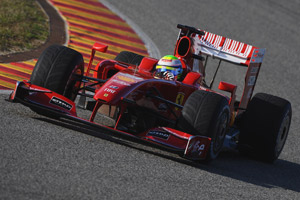
Active: 2009 - 2009
Team: Scuderia Ferrari SpA
Designers: Mario Almondo (Director of Operations), Aldo Costa (TD), and Gilles Simon (HE)
Drivers: Felipe Massa (3), Kimi Raikkonen (4)
The F60 is the fifty fifth single-seater built by Ferrari specifically to compete in the Formula 1 World Championship. The name of the car was chosen to celebrate the Scuderia's participation in all 60 editions of the Formula 1 World Championship since 1950 to date.
The project, which goes by the internal code name of 660, represents the Scuderia's interpretation of the regulations that come into force this year, which include very many new elements. As far as the aerodynamics are concerned, these modifications are the result of the work carried out by the OWG (Overtaking Working Group,) set up by the FIA in collaboration with the teams to produce a set of rules aimed at encouraging more overtaking on track: the front wing, which has a neutral central profile, common to all, is developed mainly on its side elements and is much wider than in the past: the bodywork can no longer carry the slotted apertures that had characterised the Ferrari cars over the past few years.
Other aerodynamic devices are also significantly reduced; the rear wing is higher and narrower than in the past; the diffuser has been moved rearward. The combination of changes naturally led the initial design phase down radically different routes when it came to the side pods and protection components: the apertures have been reduced in size and moved rearward, while the upper and rear elements are larger to aid the exit of air.
The new rules regarding aerodynamics have also led to modifications to the suspension, as these elements can no longer be enclosed to the same extent. The suspension system and the whole layout of the car have been redesigned in the light of the new rules in order to achieve the correct weight distribution.
The design also takes into account two other significant changes in the 2009 regulations: the possibility of using a kinetic energy recovery system (KERS) and the reintroduction of "slick" tyres. The KERS on the F60 was designed by Ferrari in collaboration with Magneti Marelli and is centrally mounted on the engine under the rear part of the chassis; its management has involved all departments of the Gestione Sportiva. The return to tyres with no grooves is another element which is down to the work of the OWG, as is the introduction of a flap on the front wing that can be adjusted by the driver when the car is moving.
The software for managing this tool, as well as for the KERS, was designed in Maranello. The transmission has been redesigned to optimise the aerodynamic efficiency of the car. The gearbox casing is again made in carbon and is still positioned longitudinally. The gearbox is fitted with a speed shifter. There is also a new braking system, with callipers designed by Brembo. Other important rule changes for this year stem from the work of FIA and FOTA (Formula One Teams Association) aimed at producing a significant reduction in the teams' operational costs.
As far as the engine is concerned, which retains its longitudinal mounting in the F60 and continues as a load bearing structure, the rules now state that a total of eight engines may be used over the 17 Grand Prix race weekends on the calendar.
Accordingly, the maximum permitted engine speed has been reduced to 18,000 rpm and the distance target for each unit is now around 2,500 kilometres. Furthermore, modifications have been made to the inlet trumpets, the position of the injectors and the configuration of the exhausts. The changes to the regulations mean that, on the reliability front, Shell has played a fundamental role in defining the lubricants for both the engine and gearbox.
As usual, the technical partners have played an important part right from the design and development stage of the entire car. Apart from the aforementioned Shell, a significant contribution has been made by the FIAT Research Centre, especially in the use of its simulation systems and by Brembo, in the development of the braking system. As usual, great attention has been paid to the management and optimisation of the materials used, at the design stage and through quality control, aimed at maximising performance while maintaining the highest possible levels of safety.
Specifications
Chassis: Carbon-fibre and honeycomb composite structure
Differential: Ferrari longitudinal gearbox, Limited-slip differential
Gearbox Semiautomatic sequential electronically controlled gearbox - quick shift; 7 gears + Reverse
Brakes: Brembo ventilated carbon-fibre disc brakes
Suspension: Independent suspension, push-rod activated torsion springs front and rear
Weight: (with water, lubricant and driver) 605 kg
Wheels: BBS Wheels (front and rear) 13"
Kers: Kinetic energy recovery system by Ferrari in cooperation with Magneti Marelli
Engine
Designation: Type 056
Configuration: Cilinder block in cast aluminium V8 90°
Number of valves: 32, pneumatically distributed
Displacement: 2398 cc
Piston bore: 98 mm
Weight: > 95 kg
Injection: Magneti Marelli digital electronic injection
Ignition: Magneti Marelli static electronic ignition
Fuel: Shell V-Power ULG-66L/2
Lubricant: Lubricant Shell[/quote]
Spoiler:
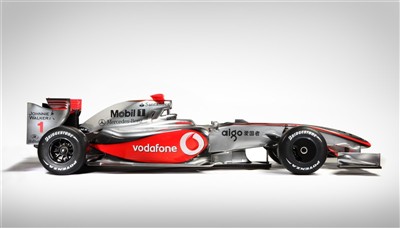
Active: 2009 - 2009
Team: McLaren International Ltd
Drivers: Lewis Hamilton (1), Heikki Kovalainen (2)
Aerodynamics
This year’s aerodynamic regulations were framed by the FIA and the Overtaking Working Group (helmed by Vodafone McLaren Mercedes engineering director Paddy Lowe, Ferrari’s Rory Byrne and Renault’s Pat Symonds) which met throughout 2007 in order to address the issues affecting passing in Formula 1.
The OWG’s influence can be most clearly seen around the front wing, which has been widened, and the rear wing – which is now more compact. Other factors affecting aerodynamics include the banning of ancillary appendages, the addition of driver-adjustable front-wing flaps and a heavily revised diffuser.
KERS
The MP4-24’s KERS device has been developed in collaboration with McLaren and Mercedes-Benz HighPerformanceEngines, which has been developing and refining the system for almost two years. The device enables the car to recover energy under braking, store the energy for a lap and release it when the driver presses a button on the steering wheel.
With a fully optimised KERS device’s output capped at 400kJ (discharging 80bhp boost for 6.7s per lap), the development team’s primary focus has already shifted to further improving the unit’s integration within the chassis in order to minimise performance loss elsewhere within the package.
An optimised KERS package can be expected to deliver a 0.3-0.5s gain per lap.
MP4-24 specifications
Chassis: McLaren moulded carbon fibre/aluminium honeycomb composite incorporating front and side impact structures. Contains integral safety fuel cell
Front suspension: Inboard torsion bar/damper system operated by pushrod and bell crank with a double wishbone arrangement
Rear suspension: Inboard torsion bar/damper system operated by pushrod and bell crank with a double wishbone arrangement
Suspension dampers: Koni
Electronics: McLaren Electronic Systems control units incorporating electronics for chassis, engine and data acquisition. McLaren Electronic Systems also supplies the electronic dashboard, alternator voltage control, sensors, data analysis and telemetry systems
Bodywork: One-piece engine cover and sidepod covers. Separate floor section, structural nose with integral front wing
Tyres: Bridgestone Potenza
Radio: Kenwood
Race wheels: Enkei
Brake calipers: Akebono
Brake master cylinders: Akebono
Batteries: GS Yuasa Corporation
Steering: McLaren power-assisted
Instruments: McLaren Electronic Systems
Engine
Type: Mercedes-Benz FO 108W
Capacity: 2.4 litres
Cylinders: 8
Maximum rpm: 18,000 (FIA regulatory limit for 2009)
Bank angle: 90°
Piston bore maximum; 98mm (FIA regulation)
Number of valves: 32
Fuel: Mobil High Performance Unleaded (5.75% bio fuel)
Lubricants: Mobil 1 – for higher performance, lower friction and better wear resistance
Weight: 95kg (minimum FIA regulation weight)
Transmission
Gearbox: Seven forward and one reverse
Semi-auto: Yes
Driveshafts: McLaren
Clutch: Hand-operated
Spoiler:
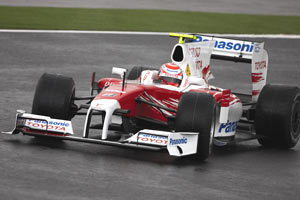
Active: 2009 - 2009
Team: Toyota Motorsports GmbH
Drivers: Jarno Trulli (9), Timo Glock (10)
Team: Tadashi Yamashina (TP), Noritoshi Arai (TD), Pascal Vasselon (General Manager Chassis)
Panasonic Toyota Racing introduced their 2009 challenger, the TF109, on January 15 at their home base in Cologne. The car is a work that started in October 2007 and the team's aim is again high. Chairman and Team Principal Tadashi Yamashina states: "Our target this year is to fight to win the first race for Toyota in Formula 1."
It is obviously a departure from its predecessor because of striking changes in the technical regulations. As a result, previous spoon shaped front wings, angel wings and chimneys are gone, in favour or a lower and wider front wing and cleaner sidepods.
TF109 specifications
Monocoque construction: Moulded carbon fibre and honeycomb construction
Fuel tank: ATL safety cell
Suspension: Carbon fibre double wishbone arrangement, with carbon fibre trackrod and pushrod
Dampers: Penske
Wheels: BBS forged magnesium
Tyres: Bridgestone Potenza
Brakes: Toyota/Brembo callipers, Brembo master cylinders, Hitco material (carbon/carbon)
Steering: Toyota power-assisted steering. Toyota carbon fibre steering wheel with Toyota / Magneti Marelli instruments
Driver's seat: Carbon fibre
Restraints: Takata
HANS device: Hubbard-Downing
Electronics: Toyota, Magneti Marelli plus McLaren Electronics Systems ECU (as required by FIA rules)
Transmission: 7-speed unit plus reverse
Dimensions
Overall length: 4636 mm
Overall height: 950 mm
Overall width: 1800 mm
Overall weight: 605 kg including driver and camera
Engine
Designation: Toyota RVX-09
Configuration: 90° V8
Capacity: 2,398cc
Horsepower: Approximately 740bhp
Revolutions: Maximum 18,000rpm (as required by FIA rules)
Valve actuation: Pneumatic
Throttle actuation: Hydraulic
Spark Plugs: DENSO
Fuel: Esso
Lubricants: Esso
Spoiler:
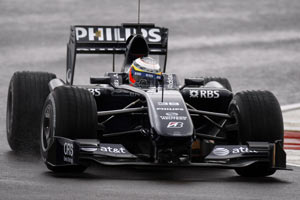
Active: 2009 - 2009
Team: Williams F1
Drivers: Nico Rosberg (16), Kazuki Nakajima (17)
Team: Frank Williams (TP), Patrick Head (DE), Sam Michael (TD), Jon Tomlinson (CA), Rod Nelson (Chief operations engineer)
The Williams-Toyota FW31 is the first major clean-sheet car design for perhaps 30 years, driven by a wholesale change in Sporting and Technical Regulations. The new Sporting Regulations are intended to increase car reliability and further reduce costs, while the changes to the Technical Regulations have three objectives – reducing the role of aerodynamics in the car’s performance, making overtaking easier and keeping lap times in check. These changes have had significant implications both on the appearance of this season’s race car and in shifting its performance baseline.
Sam Michael reflected, “The changes in the aerodynamic regulations are the most profound and will have the most impact on lap time. There are many immediate visual changes, but also many smaller reductions around the car through new regulation wording and exclusion zones. Starting at the front, the front wing end plate design has changed as the interaction with the front tyre is completely different, and important to control. There are no longer large barge boards – although we managed to squeeze a small one in. The engine cover no longer has the traditional chimneys and louvers on top for cooling, and that has forced a higher and wider exit at the rear in order to provide an effective exit for hot air. Of course the re-introduction of slick tyres is another significant change as it has an influence on the overall dynamics of the race car. Finally, of course, the introduction of KERS is another aspect to the technical picture for the year ahead.”
Michael went on to explain how the changes in aerodynamic rules, which see a much reduced rear wing geometry and conversely, a considerably wider front wing profile, fw31 angle 1with the front wing flap angle adjustable by the driver in the cockpit, would be the competitive focus for all the teams for much of the year ahead. “Aerodynamics is likely to be the key to the first two thirds of the season ahead,” he said, while rating the change to slick tyres as another significant rule change for 2009. “Finding the optimum weight distribution to optimise tyre performance will also be a high priority going into 2009 and KERS will be the next contributor to race performance. “ Michael confirmed.
The introduction of Kinetic Energy Recovery Systems (KERS) in 2009 is not an obligatory element of the regulations, but may provide an opportunity for teams to gain competitive advantage. The amount of energy that can be recovered and used may increase in future regulations, but the level set for the technology’s introductory year, set against considerations of weight and reliability, make the initial advantages less than gains to be achieved through aerodynamics and mechanical dynamics.
Sam Michael contextualised this view, saying, “KERS in 2009 could be worth between 2/10ths and 3/10ths of a second per lap. However, once aero performance converges, KERS could start to become a greater performance differentiator and if the regulations give more scope to the technology, it could be worth anything up to a second a lap and it will be needed to win Grands Prix. The key decision for us with our system is to carefully balance the potential performance advantage with our ambition to improve an already strong reliability record from last season.”
Specifications
Chassis construction: Monocoque construction fabricated from carbon aramid epoxy and honeycomb composite structure, surpassing FIA impact and strength requirements
Front suspension: Carbon bre double wishbone arrangement, with composite toelink and pushrod activated springs and anti-roll bar
Rear suspension: Double wishbone and pushrod activated springs and anti-roll bar
Transmission: Williams F1 seven speed seamless sequential semi-automatic shift plus reverse gear in a aluminium maincase, gear selection electro-hydraulically actuated
Clutch: AP Carbon plate
Dampers: Williams F1
Wheels: RAYS forged magnesium
Tyres: Bridgestone Potenza, F 350mm wide, R 375mm wide
Brake system: 6 piston AP calipers all round, Carbon Industrie carbon discs and pads
Steering: Williams F1 power assisted rack and pinion
Fuel system: ATL Kevlar-reinforced rubber bladder
Electronic systems: MES
KERS: Williams Hybrid Power’s patented Magnetic Loaded Composite flywheel system
Cooling system: Marston oil, water, and gearbox radiators
Cockpit: Driver six point safety harness with 75mm shoulder straps & HANS system, removable anatomically formed carbon fibre seat covered in Alcantara. Safety Devices extinguisher systems.
Dimensions
Weight: 605 kg with driver, camera and ballast
Wheelbase: 3100 mm
Length: 4800 mm
Height: 950 mm
Width: 1800 mm
Engine
Designation: Toyota 2.4L V8, 90° V angle, pneumatic valve train.
Fuel management and ignition systems: Toyota
Spark plugs: ND
Engine materials: include block and pistons in aluminium, crankshaft in steel billet, connecting rods in titanium
Spoiler:
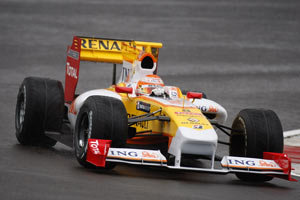
Drivers: Fernando Alonso (7), Nelson Piquet Jr. (8)
Team: Bob Bell (TD), Pat Symonds (Director of engineering), Rob White (Deputy managing director - engine), Tim Densham (CD), Dirk De Beer (HA)
Following the ING Renault F1 Team’s improving performance in 2008, the new R29 is a development in design philosophy aimed at extracting maximum performance from the new aero regulations, slick Bridgestone tyres, and KERS system, whilst further developing the strong features of the R28.
With such radical rules coming into force, particularly with respect to aerodynamics, the team placed great emphasis on maximising the R29’s time in the wind tunnel, with aero development already underway by February 2008. CFD has also played a considerable role in the design of the car and has been particularly valuable in understanding the interaction of the aerodynamic package as a whole.
There has been a concerted effort to save as much weight as possible on the R29 to allow for the introduction of the KERS system. As a result, the design team has moved towards using alternative materials and construction methods, such as the carbon-titanium gearbox casing, increased use of MMC aluminium and magnesium.
Renault started the design work of the KERS system in 2007 in conjunction with Magnetti-Marelli. The system consists of a motor-generator, which is connected to the front of the engine (this charges the battery on braking and releases the energy under acceleration), a battery pack located in the chassis and a KERS control unit.
The front end of the car is dominated by the 2009 aero specification wide front wing which has a driver controlled adjustable incidence flap. This looks very different to previous years being much closer to the ground and has much greater influence on the air flow over the tyres due to its increased span. Great attention has therefore been paid to the end plates which have become much more critical devices than they have been in previous years. The front end also has a more radical front suspension layout with new geometry including inclined wishbones and higher monocoque in order to maximise the new slick tyres and improve aerodynamic efficiency.
The rear of the monocoque under the bodywork has changed considerably with the integration of the KERS system, which has taken a lot of effort to package neatly for the minimum weight. The introduction of this new technology has also influenced the car’s aero package with careful consideration paid to ensure sufficient cooling.
The bodywork appendages, such as winglets, flicks and chimneys have now largely disappeared with the 2009 aero regulations. The surfaces are therefore much simpler and more streamlined, although the R29 still incorporates the R28-type dorsal fin and flush exhaust exits seen on previous Renault F1 cars. The 2009 rear wing is narrower and higher and reverts back to the centrally-supported single pylon design first introduced on the R26.
The four-race gearbox has a brand new carbon-titanium main case to save weight, and an improved gearshift system developed on the R28, which has also reduced weight and improves performance. The R29 therefore shares little in common with its predecessor with much of the car designed from a clean sheet of paper. This is particularly true of the aerodynamic package where efforts in the past have concentrated on evolutionary design. The technical team has risen to the challenges of this shake-up in the rules and looks forward to seeing the results of their efforts on the racetrack when the R29 makes its debut this January.
Production timeline
08/01/2008 Wind tunnel work commences on R29 in Enstone
28/03/2008 Car specification first issue
31/03/2008 Gearbox design begun
11/04/2008 Rear suspension inboard parts defined
12/04/2008 Chassis design begun
02/05/2008 Gearbox production begun
20/06/2008 Location of KERS parts defined
23/06/2008 Front suspension geometry defined
24/06/2008 Chassis surfaces finalised by aero department
18/07/2008 Rear suspension geometry defined
27/08/2008 KERS battery pack prototype assembled
09/09/2008 Chassis manufacturing begun
17/09/2008 Gearbox machining begun
26/09/2008 Bodywork defined by aero department
12/11/2008 Car mock-up assembly begun
01/12/2008 Driver fits in first mock-up chassis
01/12/2008 Dyno test of gearbox internals in Viry
09/12/2008 Dyno test of gearbox with new case in Viry
12/12/2008 First chassis assembly completed
15/12/2008 First car build started (R29-01)
22/12/2008 First car fired up in workshop
29/12/2008 R&D testing of first car begun
05/01/2009 Final wind tunnel testing completed for first race package
07/01/2009 Driver fits in actual R29 chassis completed
14/01/2009 First straight-line running of R29
19/01/2009 First circuit test of R29 and official car revelation
18/03/2009 Cars leave for first race
29/03/2009 2009 Australian Grand Prix
Specifications
Chassis: Renault R29
Construction: Moulded carbon fibre and aluminium honeycomb composite monocoque, manufactured by the Renault F1 Team and designed for maximum strength with minimum weight. RS27 V8 engine installed as a fully-stressed member.
Front suspension: Carbon fibre top and bottom wishbones operate an inboard rocker via a pushrod system. This is connected to a torsion bar and damper units which are mounted inside the front of the monocoque. MMC aluminium uprights and machined magnesium wheels.
Rear suspension: Carbon fibre top and bottom wishbones operating angled torsion bars and transverse-mounted damper units mounted on the top of the gearbox casing. MMC aluminium uprights and machined magnesium wheels.
Transmission: Seven-speed semi-automatic carbon-titanium gearbox with reverse gear. “Quickshift” system in operation to maximise speed of gearshifts.
Fuel system: Kevlar-reinforced rubber fuel cell by ATL.
KERS: Motor generator unit driving into front of engine with batteries as an energy store.
Cooling system: Separate oil and water radiators located in the car's sidepods and cooled using airflow from the car's forward motion
Electrical: MES-Microsoft Standard Electronic Control Unit / Magnetti-Marelli KERS control unit.
Braking system: Carbon discs and pads (Hitco); calipers and mastercylinders by AP Racing.
Cockpit: Removable driver’s seat made of anatomically formed carbon composite, with six-point harness seat belt. Steering wheel integrates gear change and clutch paddles, front flap adjuster and KERS energy release controls.
Car dimensions and weight
Front track: 1450 mm
Rear track: 1400 mm
Overall length: 4800 mm
Overall height: 950 mm
Overall width: 1800 mm
Overall weight: 605 kg, with driver, cameras and ballast
Engine
Designation: Renault RS27
Capacity: 2400 cc
Architecture: 90° V8, naturally aspirated
Weight: 95 kg
Max rpm: 18,000 rpm
Fuel: Total
Oil: Total
Battery: Renault F1 Team
Spoiler:
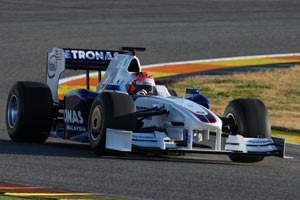
Drivers: Robert Kubica (5), Nick Heidfeld (6)
Team: Mario Theissen (BMW Motorsport director), Walter Riedl (Managing Director), Willy Rampf (Technical coordinator), Markus Duesmann (HP), Christoph Zimmermann (CD), Williams Toet (HA), Beat Zehnder (TM)
As 2009 sees arguably the most significant rewrite of the F1 technical rulebook in the history of the sport, the BMW Sauber F1.09 is practically a clean sheet design. Completely redefined aerodynamics, the return of slicks and the option of fitting KERS (Kinetic Energy Recovery System) technology have literally brought the teams back to the drawing board.
During the course of 2007, the OWG (Overtaking Working Group) set out a plan to ease overtaking and decided that the best way to do this was reduce downforce. In order to have an acceptable overtaking difficulty, a car's total downforce had to be reduced by 40%. As a result, the front wing has grown in width from 1400 mm to 1800 mm, making it as broad as the car as a whole. Conversely, the rear wing's width was reduced to 750 mm and its maximum height increased.
For Willy Rampf, the man responsible for the car's concept, and Walter Riedl, responsible for the development of the new car, this project has represented a memorable challenge. “Developing a new Formula One car is always exciting, but this time there was something even more special about it. We really were starting from scratch,” says Rampf.
The combination of the return of slicks with the possible use of KERS technology places particular importance on weight distribution. “First and foremost, the switch from grooved tyres to slicks means more grip, of course, but it also moves the balance of forces further forward: removing the grooves
gives the front tyres proportionally a greater contact area and more grip than the rear tyres,” explains Rampf. Consequently, more weight has to be shifted towards the front of the car and the aero balance adjusted likewise.
Compared to its competitors in the 2009 season, the BMW Sauber has fairly high sidepods that slope down towards the centre of the car. It is specifically shaped around the radiators to provide sufficient cooling for the engine, its ancilliaries and the KERS components. The sidepod still features small louvers close to the car's floor to form a hot air outlet, together with the rear end of the sidepod.
The nose and front wing are fairly similar to most other cars, except the the front wing's panels are held up with a fence, rather than a simple aluminium linkage.
Mechanically, the new car features a new front and rear suspension to make optimal use of the new slick tyres. Added to that, the gearbox casing - still produced in titanium - was revised but contains an almost identical internal component setup.
Rampf and Riedl further mentioned that they have put a lot of attention to the design of the front wing. The team carefully simulated several alternatives with its 'Albert3' supercomputer before deciding and optimising the best design. Because of the total reduction in downforce, they also admitted that the new car will run with maximum downforce at a lot more circuits than in 2008. When looking back on its initial development phase, most of the work appears to have gone into the aerodynamics, the optimisation of tyre usage and the integration of KERS.
Specifications
Chassis: carbon-fibre monocoque
Suspension: upper and lower wishbones (front and rear),
inboard springs and dampers, actuated by pushrods (Sachs Race Engineering)
Brakes: six-piston brake callipers (Brembo), carbon pads and discs (Brembo, Carbone Industrie)
Transmission: G1.09 7-speed 'quick-shift' gearbox designed to last 4 races, longitudinally mounted, carbon-fibre clutch
KERS: System with energy storage in batteries, BMW Sauber F1 Team
Chassis electronics: MES
Steering wheel: BMW Sauber F1 Team
Tyres: Bridgestone Potenza
Wheels: OZ
Dimensions
Length: 4690 mm
Width: 1800 mm
Height: 1000 mm
Track width, front: 1470 mm
Track width, rear: 1410 mm
Weight: 605 kg (incl. driver, tank empty)
Engine
Type: BMW P86/8, normally aspirated V8
Bank angle: 90 degrees
Displacement: 2,400 cc
Valves: four per cylinder
Valve train: pneumatic
Engine block: aluminium
Cylinder head: aluminium
Crankshaft: steel
Oil system: dry sump lubrication
Engine management: standard ECU (MES)
Spark plugs: NGK
Pistons: aluminium
Connecting rods: titanium
Dimensions:
- Length: 518 mm
- Width: 555 mm
- Height: 595 mm (overall)
Maximum engine speed: 18000 rpm
Edit: Added the spoiler BBCode so that it will be easier to find the car one is looking for. Red Bull, Toro Rosso and Force India's and any other teams specification will be posted when they are revealed.










